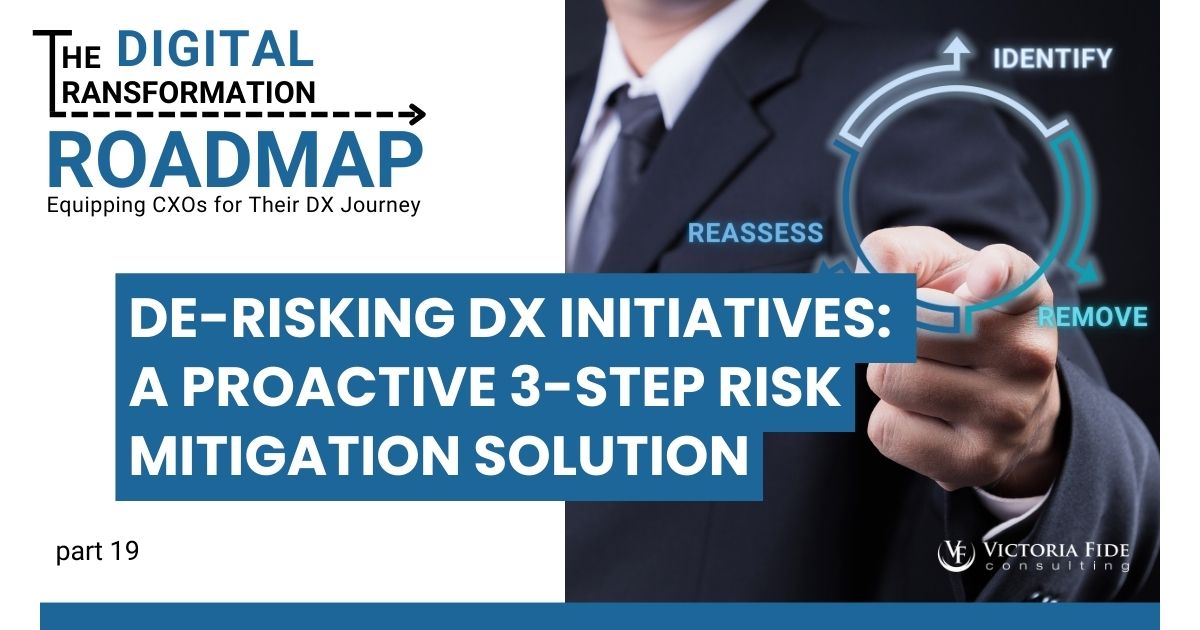
De-Risking DX Initiatives: A Proactive 3-Step Risk Mitigation Solution
The DX Roadmap series is produced by Victoria Fide Marketing with input and oversight from our leadership team and industry SMEs.
Table of Contents
Risk mitigation is crucial for digital transformation (DX) projects. With project failure rates hovering anywhere between 70% and 80%, effective risk mitigation can help organizations prepare for and successfully overcome barriers in their DX initiatives.
Effectively mitigating risks begins long before project kickoff. By following the preparatory steps outlined in our Digital Transformation Roadmap such as building a Project Management Plan and conducting an Organizational Risk Assessment, you will be able to gather the information needed to properly identify, document, and mitigate risks. The more proactive you are in addressing these concerns, the less impact they will have on the project’s progress and health.
In this article, we will cover the 3-step process to mitigating risk before project kickoff, enabling organizations to foster project success and a smooth transition during the transformation process.
Risk Mitigation: Methodically Removing Barriers to Success
While some issues are challenges that need immediate intervention, risks are potential events that could cause future problems. Proactively mitigating risks is typically more cost-effective, less disruptive, and easier than resolving issues after they permeate and disrupt the project. Effective risk mitigation involves identifying, addressing, and reassessing potential problems to minimize their impact on the organization and the project.
Your Risk Management Plan – part of your Project Management Plan (PMP) – defines how risks will be tracked and reported. As we begin taking steps to identify and remove risks, it will be important to refer back to your risk management plan to ensure consistency, communication, and transparency.
Our proactive risk mitigation process consists of three fundamental steps designed to significantly improve project success rates: identify the barriers, remove the barriers, and reassess the risks. Let’s explore each step in more detail.
Step One: Identifying and Analyzing Potential Challenges
Throughout the Prepare Phase, you will likely have identified potential problems and challenges through discussions with stakeholders or team members. In this first step of Identify, you will need to formally document these potential barriers with the goal of addressing them before they escalate into active issues.
Adhere to your Risk Management Plan by tracking and reporting the risks appropriately and be sure to involve the entire project team to gather diverse perspectives. You may use risk assessment techniques such as brainstorming, checklists, or SWOT analysis (Strengths, Weaknesses, Opportunities, and Threats). This will allow you to measure the projected impact on the project and set the priority accordingly.
Step Two: Removing Barriers to Digital Transformation Success
After all known potential barriers have been identified and documented, it is time to remove them. Begin by reviewing the risks with project sponsors or stakeholders to create detailed mitigation plans for each barrier. The mitigation plan should include what actions will be taken, when to expect an update or resolution, and who is responsible for following up on the status of the risk.
If any risks can be resolved immediately, implement the mitigation plans without delay; this prevents them from escalating into larger issues. The more risks that can be addressed now before project kickoff and the Execute phase, the greater the chance of project success.

Transformation is not easy, but it doesn’t have to be impossible. Take control of your project’s success today and schedule a free 30-minute consultation to find out how Victoria Fide can equip you for transformational success.
Step Three: Reassessing Current Risks for Ongoing Responsiveness
Following the initial identification, review, and mitigation of potential barriers, the next step is to reassess the current risks before the project kickoff. This reassessment ensures that any remaining or newly emerged risks are appropriately managed and communicated.
During the reassessment, revisit the initial list of barriers to identify any that still pose a threat. For those risks that have been fully mitigated, review the outcomes to ensure they remain under control. For any risks that remain open, ensure that the mitigation plan lists any action that has been taken thus far, then determine any additional required actions and the person responsible for owning them.
Some concerns may be broad enough to warrant addressing at the project kickoff event. Discuss these risks openly to ensure all stakeholders are aware of potential issues and can contribute to their ongoing mitigation.
Reassessing risks should not remain a one-time event. Establish a schedule for routine risk assessment, whether that is daily, weekly, or at other regular intervals based on the priority and impact of the risks. Regular reviews help ensure that emerging risks are promptly identified and managed, and the project team is aware, responsive, and poised to minimize negative impacts of potential threats.
Real-World Applications of the 3-Step Risk Mitigation Process
Let’s take a look at how this 3-step process of Identify, Remove, and Reassess unfolds in real world scenarios:
Scenario One: Narrowing the Skills Gap
During team member evaluation, significant skills gaps were identified. In this case, the team needed a specific member to act as a Business Process Owner (BPO). In the past, this employee functioned as an effective Subject Matter Expert (SME), but lacked the skillset necessary to be an effective voice of the process.
- Identify: Formally document the details surrounding the skills gaps, such as which team members are affected and the impact it may have on project deliverables. Perform a SWOT analysis to determine level of impact and priority for this barrier.
- Remove: The Project Sponsor and Project Manager meet to determine a mitigation plan. To remove the skills gap, they decide to involve other roles to better support the project. Furthermore, they provide access to additional training, and build extra time into the project timeline.
- Reassess: Before project kickoff, review the skills gap barrier and conduct follow-up interviews to evaluate the efficacy of the mitigation plan, and adjust if necessary.
Scenario Two: Reducing Stakeholder Resistance
During the Organizational Maturity and Risk Assessment activities, a stakeholder emerged as resistant to the DX initiative, considering it overly disruptive and unnecessary. Despite this dissent, the Senior Leadership Team collectively decided to proceed with the DX initiative.
- Identify: The Project Manager formally documents this potential barrier, including all the feedback and results gathered from the assessment activities. The risk is then assigned impact and priority according to the Risk Management Plan in the PMP.
- Remove: The Project Sponsor proposes a mitigation plan to remove the disagreement between the stakeholder and the Senior Leadership Team. Part of the plan includes proactive conversations regarding the benefits of the DX initiative, as well as hands-on activities with the stakeholder to demonstrate the value and potential impact on their role.
- Reassess: After implementing the mitigation plan, the Project Sponsor reassesses the stakeholder’s attitude towards the DX initiative. If there is still resistance, additional stakeholders will be pulled in, or the barrier will be escalated to senior management for further intervention. The Project Sponsor will continually reassess until an amicable solution is achieved.
Scenario Three: Streamlining Legacy System Modernization
During the initial Scope and Status Assessment, one company determined that they had a significant need to move the Operations Team from their existing legacy system to modern technology to take advantage of new automation.
- Identify: Discussions with stakeholders highlight the importance of leveraging new automation capabilities, which necessitates an overhaul of existing systems and processes in the production and warehouse areas. With such substantial changes, this is documented as a significant barrier with large potential impact to the project and the organization.
- Remove: The team reviews this identified risk with project sponsors and stakeholders to formulate a detailed mitigation plan. This plan – designed to remove the risk associated with modernizing the legacy system – includes scheduling additional time for activities such as assessing current processes, designing new systems, and rigorous testing to ensure a smooth transition. Responsibilities are assigned along with regular updates and follow-ups to ensure continuous progress.
- Reassess: Following the formulation of the mitigation plan, the team undertakes continuous reassessment of this risk. This involves regular reviews at scheduled intervals, ensuring that new challenges will be managed proactively. Updates are communicated to stakeholders regularly to maintain transparency and align expectations, thereby minimizing any negative impacts on project progress.
By following these risk management steps—Identify, Remove, and Reassess—these teams are able to address significant barriers effectively, keeping their projects on track and reducing the likelihood of unexpected disruptions.

De-Risking Your Digital Transformation Initiative
Proactively addressing barriers is critical to the successful execution of any project. By anticipating and mitigating potential risks at the earliest stages, project teams can build a strong foundation for ongoing risk management throughout the implementation process.
The 3-Step process of Identify, Remove and Reassess empowers the team to proactively address any issues that may arise, and keeps all stakeholders informed and engaged through regular communication and review. Continuous reassessment of risks ensures the team can remain agile and responsive, increasing the likelihood of meeting project goals and timelines.
If you want help de-risking your DX initiative, contact Victoria Fide or learn more about our 100% Client Success Guarantee. Don’t forget to subscribe for more digital transformation content and best practices based on Victoria Fide’s Proven Process for Transformational Change.
Subscribe to our weekly LinkedIn Digital Transformation Success newsletter and get notified of each new edition.
